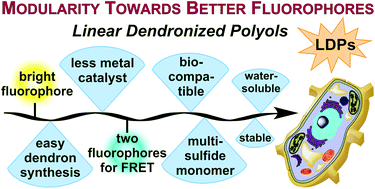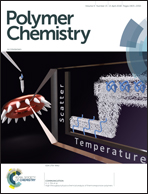Linear dendronized polyols as a multifunctional platform for a versatile and efficient fluorophore design†
Abstract
Fluorescent linear dendronized polyols (LDPs) were prepared in two steps involving a ring-opening metathesis polymerization (ROMP) followed by acid-catalyzed deprotection. The resulting water-soluble fluorophores are compact in size (<6 nm) and show similar photostability compared to previously reported crosslinked dendronized polyols (CDPs) and significantly improved photostability compared to the free fluorophores. In contrast to the synthesis of CDPs, the production of LDPs requires less preparation time, synthetic effort, and significantly less Grubbs catalyst. The photophysical properties, including the photostability and emission wavelength of LDPs, can be further fine-tuned by incorporating different combinations of dendronized monomers and fluorophores. Interestingly, fluorescence resonance energy transfer (FRET) was observed when two different kinds of fluorophores were incorporated into the LDPs. This provides a new type of fluorophore with a large Stokes shift allowing fluorescence detection with reduced background overlap. Cytotoxicity and fluorescence imaging studies confirmed the biocompatibility of these LDPs, which make them potential candidates for biological applications.



 Please wait while we load your content...
Please wait while we load your content...